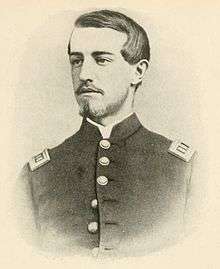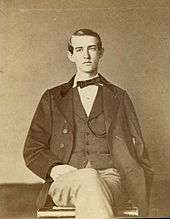Ulric Dahlgren
| Ulric Dahlgren | |
|---|---|
 Col. Ulric Dahlgren (seen here as a captain) | |
| Born | April 3, 1842 |
| Died |
March 2, 1864 (aged 21) (near Stevensville), King and Queen County, Virginia |
| Buried at | Laurel Hill Cemetery, Philadelphia |
| Allegiance |
Union |
| Service/branch |
|
| Years of service |
1861 - 1862 (Union Navy) 1862 - 1864 (Union Army) |
| Rank |
|
| Wars | American Civil War |
| Relations | Rear Admiral John A. Dahlgren (father) |
Ulric Dahlgren (April 3, 1842 – March 2, 1864) was a colonel in the Union Army during the American Civil War. In 1864, he led an unsuccessful raid on the Confederate capital of Richmond, Virginia, and was killed. The failed raid resulted in the Dahlgren Affair after incriminating documents were discovered on Dahlgren's corpse.
Early life
Ulric Dahlgren was born April 3, 1842, to Rear Admiral John A. Dahlgren and Mary Clement Bunker.[1]

A second son to his parents, Dahlgren was born in Bucks County, Pennsylvania.
After completing school in 1858, Dahlgren's U.S. Navy father supplied him with instruction in the field of civil engineering and by 1859, he was busy surveying land in Mississippi. In September 1860, with the support of his father who appears to be steering his son away from public service, he ventured to Philadelphia, Pennsylvania where he found work at a law office.
American Civil War
Following the inauguration of the 16th U.S. President, Abraham Lincoln, in March 1861, young Dahlgren appears to be 'bitten' by the same public service 'bug' as his father was and thus before July 24, 1861 he too joined the U.S. Navy since on that date he was on a U.S. Navy expedition from the Washington Ship Yard to help in the defense of Alexandria, Virginia. On May 29, 1862, Ulric Dahlgren was switched from the U.S. Navy to the U.S. Army and promoted to U.S. Army Captain by the 27th U.S. Secretary of War Edwin M. Stanton who quickly recognized his gunnery talent while at Harpers Ferry. He was active on behalf of the U.S. Army at the 2nd Battle of Bull Run and the Battle of Fredericksburg both in 1862 and at the Battle of Chancellorsville, the Battle of Brandy Station, as well as the Battle of Gettysburg in 1863. Wounded on July 6, 1863 while trying to reach Hagerstown, Maryland, he had to have his foot amputated.
For these efforts, the U.S. Army Captain received a Commission as a Colonel on July 24, 1863. With his wound sufficiently healed, the U.S. Army Colonel returned to the battlefield on February 18, 1864, under the command of U.S. Army Brigadier General, U.S. Volunteers, Hugh Judson Kilpatrick in time for a so-called 'Kilpatrick Raid' upon the Confederate Capital City of Richmond, Virginia where he was killed in action.
Papers found on Dahlgren's corpse shortly after his death contained orders for an assassination plot against Confederate President Jefferson Davis. The discovery and publication of the Dahlgren Papers sparked controversy in the South. The disrespectful display of Dahlgren's corpse in Richmond inflamed Northern public opinion, until the intervention of Elizabeth Van Lew enabled its burial, at considerable risk to the Union spy network she ran in the Confederate capital. The papers may have contributed to John Wilkes Booth's decision to assassinate U.S. President Abraham Lincoln a year later.[2]
See also
References
- ↑ Dahlgren p. 11
- ↑ Wittenberg, Eric J. "Ulric Dahlgren in the Gettysburg Campaign". Retrieved 2009-02-16.